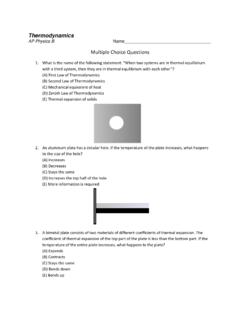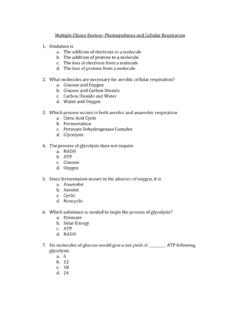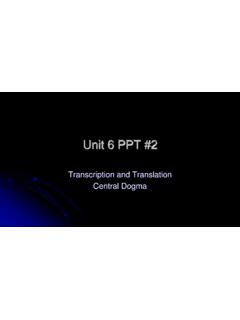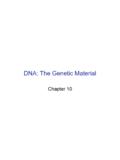Transcription of Genes DNA Replication - NJCTL
1 Biology Genes Genes DNA Replication Classwork 1. Explain why it is necessary to be able to replicate DNA in order to sustain life. 2. What is the appropriate scientific term used to describe a series of bases that code for a protein? 3. If a strand of DNA is found to contain 250 adenine bases, how many thymine bases does it have? 4. Suppose you are analyzing a strand of DNA that contains 400 cytosines. If the strand contains a total of 1,000 bases, how many adenines does it contain? Why do you know this to be true? 5. Why are the two strands of a molecule of DNA referred to as complementary? 6. What is a template strand in terms of DNA Replication ? 7. What is the physical difference between a 5 end and 3 end of a DNA molecule?
2 8. DNA strands are considered to be antiparallel. How would the molecule appear differently if they were parallel instead? 9. Why are new DNA strands only created in a 5 3 direction? 10. A landmark study in DNA Replication research by Meselson and Stahl involved growing bacteria including an isotope of nitrogen 15N and then placing these bacteria in a medium containing only 14N. According to the known method of DNA Replication , what do you predict the ratio of the two isotopes would be in DNA from the first round of reproduction? 11. In what way is DNA polymerase similar to a waiter or waitress in a restaurant? 12. DNA polymerase (specifically Taq polymerase) has to be added to the mixture when DNA is placed in a PCR machine.
3 Explain the importance of adding the polymerase. 13. A forensic technician has placed a single strand of DNA into a PCR machine, along with appropriate polymerases and primers. How many DNA molecules will be present after 20 cycles? 14. Suppose you are a doctor studying a disease that destroys DNA polymerase enzymes in the cell. What impact do you predict this will have on the reproductive ability of the affected cells? Homework 15. Why do we often describe a DNA molecule as an archive of information? 16. Can you accurately predict the number of cytosine bases found in a DNA strand if provided with only the number of thymine bases in that strand? 17. Match the single strand of DNA below with its complementary strand: TACGGCATC Biology Genes 18.
4 Supposed you are analyzing a strand of DNA that contains 375 thymines. If the strand has 900 bases, how many guanines does it have? 19. In a newly replicated molecule of DNA, how much of the molecule has just been synthesized, and how much was pre-existing? 20. What end of the DNA strand has a phosphate group attached? The 5 , or the 3 ? 21. The area of a DNA molecule where the Replication process takes place is often referred to as a Replication fork. Explain why you think this term is used to describe this location. 22. Explain what the term antiparallel means in terms of DNA Replication . 23. Does DNA polymerase use the template strand or the daughter strand to complete the Replication process? Explain. 24. A forensic technician has placed a single strand of DNA into a PCR machine, along with appropriate polymerases and primers.
5 How many DNA molecules will be present after 50 cycles? 25. Temperature is very important in the PCR process. Explain. Transcription Classwork 26. How does the sequence of nitrogenous bases affect the appearance of a molecule of RNA? 27. Why is the process of transcription essential to the utilization of DNA? 28. What role does the promoter region of a DNA sequence play in the transcription process? 29. Does RNA polymerase bind to the template strand or non-template strand of DNA? Explain why this makes sense for creating RNA that contains the needed information contained in the DNA molecule. 30. Match the strand of DNA below with its appropriate mRNA sequence. TACGGTCATTGA 31. Considering the 5 and 3 ends, in which direction is a molecule of RNA synthesized?
6 32. Why are both the non-template DNA strand and mRNA both 5 3 in orientation? 33. Which nitrogen base is involved in transcription but not DNA Replication ? Why is this the case? Homework 34. How does the sequence of bases impact the physical structure of RNA differently than DNA? 35. What enzyme conducts the process of transcription in cells? 36. What does the m in mRNA represent? Why did scientists designate it with this name? 37. Match the strand of DNA below with its appropriate mRNA sequence. TACTGGTTCAGC Biology Genes 38. Compare the promoter and termination sequences of DNA to a traffic light. 39. Does the process of DNA Replication involved uracil? Why or why not? 40. How does a strand of mRNA compare to the non-template strand of DNA from which it was created?
7 gene Expression Overview Classwork 41. How many nitrogen bases compose a single codon? 42. What is the relationship between codons and proteins? 43. Create a flow chart using words and arrows to show the entire process of gene expression. (You should use 5 words) 44. What three letters will begin all mRNA sequences that code for proteins? Explain your answer. 45. What is the central dogma of biology? Explain why this saying is used to describe the biological concept. 46. If you were to sequence the DNA of a housefly, what bases would you find in its genome? 47. Why are DNA, RNA and their codons referred to as the universal code of life? 48. What does the comprehensive gene expression process throughout living organisms suggest about the origins of life?
8 49. Sometimes the term protein synthesis is used to describe gene expression. Explain the relevance of this term to this process. 50. The fact that a single amino acid may be coded for by multiple codons may help to diminish the negative effects of a DNA mutation. Explain why this may be true. 51. How are the termination steps of transcription and translation different? 52. What amino acid is specified by the codon AUG? 53. What amino acid is specified by the codon UCG? Homework 54. In what way are codons similar to airport codes? (ex. PHL = Philadelphia) 55. What amino acid will you find in the beginning of all sequences that create proteins? 56. What DNA and RNA bases would you find in the DNA of a blue whale? 57.
9 How many codons, when expressed, will stop the translation process? 58. Explain why the term gene expression is utilized when describing the process of generating protein from DNA. 59. How could a change in the DNA sequence of a gene have an impact on the translation process? 60. Suppose an error occurs in the translation phase of gene expression. Will this error affect the DNA sequence of the gene ? Why or why not? 61. In which step (initiation, elongation, termination) are new amino acids added during translation? Biology Genes 62. How are the codons that specify a protein similar to the words that make up a sentence? What would happen if you were to change the sequence of the words? 63. What amino acid is specified by the codon UCA?
10 64. What occurs in the translation process when the codon UGA is reached? Translation Classwork 65. Why is the term translation appropriate for the last step of gene expression? 66. What is the role of rRNA in the process of protein synthesis? 67. What does the t in tRNA represent? Why is this an appropriate name when considering the role of this molecule in the translation process? 68. What part of a tRNA molecule specifies the amino acid to which it will bind? 69. How does the codon sequence of mRNA specify which tRNA molecules will bind to the mRNA? 70. If an mRNA codon reads UGC, what is the anticodon on the tRNA molecule with which it will bind? What amino acid will this tRNA molecule carry? 71. What is the anticodon on the first tRNA molecule that will begin every translation process?



















